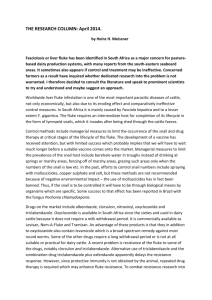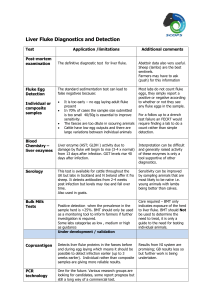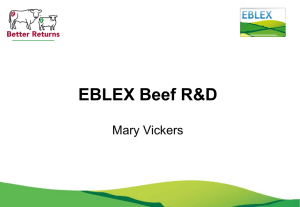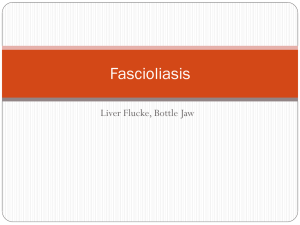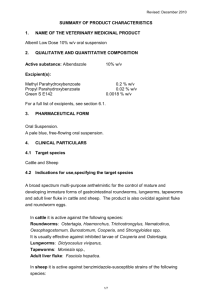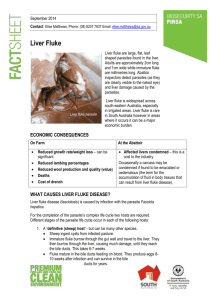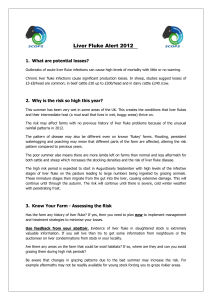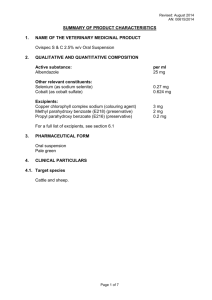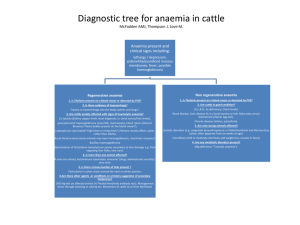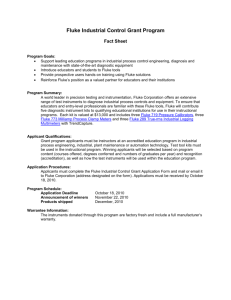Treatment options and products
advertisement
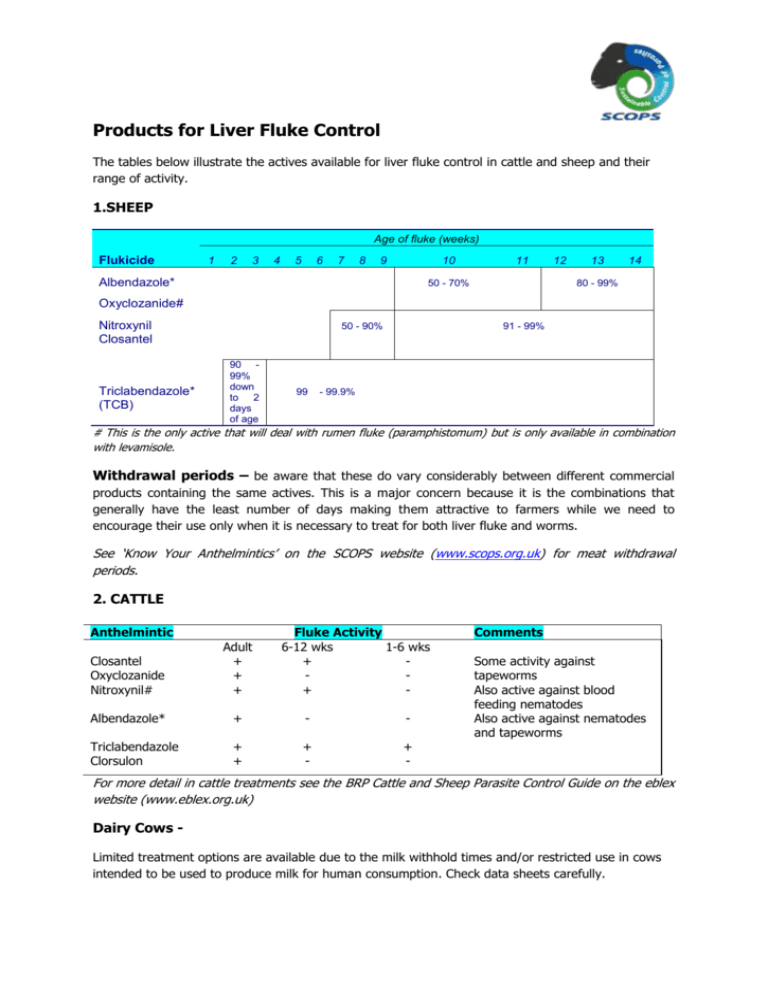
Products for Liver Fluke Control The tables below illustrate the actives available for liver fluke control in cattle and sheep and their range of activity. 1.SHEEP Age of fluke (weeks) Flukicide 1 2 3 4 5 6 7 8 9 10 Albendazole* 11 50 - 70% 12 13 14 80 - 99% Oxyclozanide# Nitroxynil Closantel Triclabendazole* (TCB) 50 - 90% 90 99% down to 2 days of age 99 91 - 99% - 99.9% # This is the only active that will deal with rumen fluke (paramphistomum) but is only available in combination with levamisole. Withdrawal periods – be aware that these do vary considerably between different commercial products containing the same actives. This is a major concern because it is the combinations that generally have the least number of days making them attractive to farmers while we need to encourage their use only when it is necessary to treat for both liver fluke and worms. See ‘Know Your Anthelmintics’ on the SCOPS website (www.scops.org.uk) for meat withdrawal periods. 2. CATTLE Anthelmintic Fluke Activity 6-12 wks 1-6 wks + + - Closantel Oxyclozanide Nitroxynil# Adult + + + Albendazole* + - - Triclabendazole Clorsulon + + + - + - Comments Some activity against tapeworms Also active against blood feeding nematodes Also active against nematodes and tapeworms For more detail in cattle treatments see the BRP Cattle and Sheep Parasite Control Guide on the eblex website (www.eblex.org.uk) Dairy Cows Limited treatment options are available due to the milk withhold times and/or restricted use in cows intended to be used to produce milk for human consumption. Check data sheets carefully. Treatment Options (NB Check data sheets very carefully. There are significant variations in activity between products and between sheep and cattle) Triclabendazole (TCBZ) is the only active capable of killing the majority of immature fluke (down to 2 days old sheep; 2 weeks old in cattle). This makes it the drug of choice for autumn treatments unless there is evidence of resistance. Closantel will kill fluke over 5 weeks of age in sheep. If used as an alternative to TCBZ then two treatments will be required at an interval of 10-12 weeks but in high risk years re-treatment may be required after just 6 weeks. Nitroxynil also required two treatments with a minimum interval of 7 weeks between them. Housing can be a useful tool, particularly for cattle. Where the risk of acute disease (or challenge ) is low, delaying treatment until 6 (closantel) or 7 (nitroxynil) weeks post-housing provides an alternative to TCBZ. Clorsulon can also be used for cattle. In all cases, the need to move the animals to low risk grazing (or house) post-treatment is essential. Failure to do so will result in re-infection and the risk of clinical disease and the need for further treatments. Dosing in the spring to remove egg laying adult fluke will reduce infection on the pastures later in the season. In this case an adulticide can normally be used, reserving TCBZ for use in the autumn. Management Options and Planning Forward planning is an essential part of liver fluke control because taking action early can have significant impact on the level of challenge for stock later in the year and in to the next season. Identification of high risk areas and either avoiding them or fencing them off is a vital part of liver fluke control and must form an important part of flock/herd Health planning. Building up a detailed assessment of these areas and planning ahead to avoid them at peak risk periods is as important as treatment and detection. Don’t forget that poaching, particularly by cattle provides a habitat for snails in areas that may not normally be considered a risk. Other options include provision of water troughs as an alternative to high risk drinking spots. This is possibly more important in drier years when animals congregate is these areas and therefore spend a lot of time, at high stocking density in a high risk area. Triclabendazole (TCBZ) Resistance Resistance to TCBZ has had a high profile over the last couple of years and there are now confirmed cases in the UK. However, there is a danger that over reaction to this may create problems. For example, farmers using the wrong product type (such as the adulticide albendazole) against acute liver fluke resulting in serious disease. The other major risk is that farmers move towards closantel or nitroxynil and drive selection pressures for resistance to these chemicals. Evidence of this is already being seen, for example in NI and the danger is that this is based on fear rather than individual farm based information such as drench and FECRT tests. A drench check, followed up by FECRT if there is a failure, is therefore a fundamental part of the recommendations emerging from this workshop. Treatments in Quarantine If there is a risk that the in-coming stock are from a liver fluke infected farm then they need to be treated. The choice of treatment depends on the status of the receiving farm : 1. No liver fluke on receiving farm and minimal risk of any snail habitats to support imported fluke means treatment is only necessary to prevent disease in the in-coming stock. 2. No liver fluke on the receiving farm but there is a risk that snail habitats to support imported liver fluke are present, so treatment is to avoid bringing infection on to the farm. 3. The destination farm has a history of liver fluke so the aim is to avoid importing TCBZ resistant liver fluke There are three treatment options for in-coming stock: Triclabendazole – but this must be followed up by a drench check. OR Closantel x 2 at 6 weeks intervals, with animals grazing low risk pasture between treatments and after the second if possible. OR Animals to be housed could have closantel, nitroxynil or clorsulon treatment(s). Delaying treatment until after housing if animals are not at risk of immediate disease will mean only one treatment is necessary. SCOPS Principles for Liver Fluke: There are no refugia based strategies for liver fluke which would help slow the development of anthelmintic resistance. Protecting the efficacy of the existing chemical groups must rely on the other SCOPS principles of best practice. In summary these are: Reduce dependence on chemical treatments by adopting management options. Plan ahead to avoid high risk areas and reduce levels of infection on the farm in the future. Assess the risks every year and use the monitoring tools available and abattoir feedback Choose the right product. TCBZ should be used when killing immature liver fluke is a priority. Alternatives should be considered at other times. Dose correctly to the weight of animal*, using the correct technique. Take particular care with pour-on products on cattle. Check for resistance – take post treatment Faecal samples as directed by your Vet. Quarantine and treat if required. *NB Dose rate according to weight is critical but because of the risk of over –dosing with closantel in particular it may be necessary to make sure farmers split groups into relatively narrow eight ranges for treatment. More information is available: Sheep – SCOPs Technical Manual (Chapter 7) 4th Edition 2012 at http://www.scops.org.uk/vets-manual.htm Cattle – COWS Technical Manual 2010 http://www.eblex.org.uk/documents/content/research/cows_manual_2010_plus.pdf
